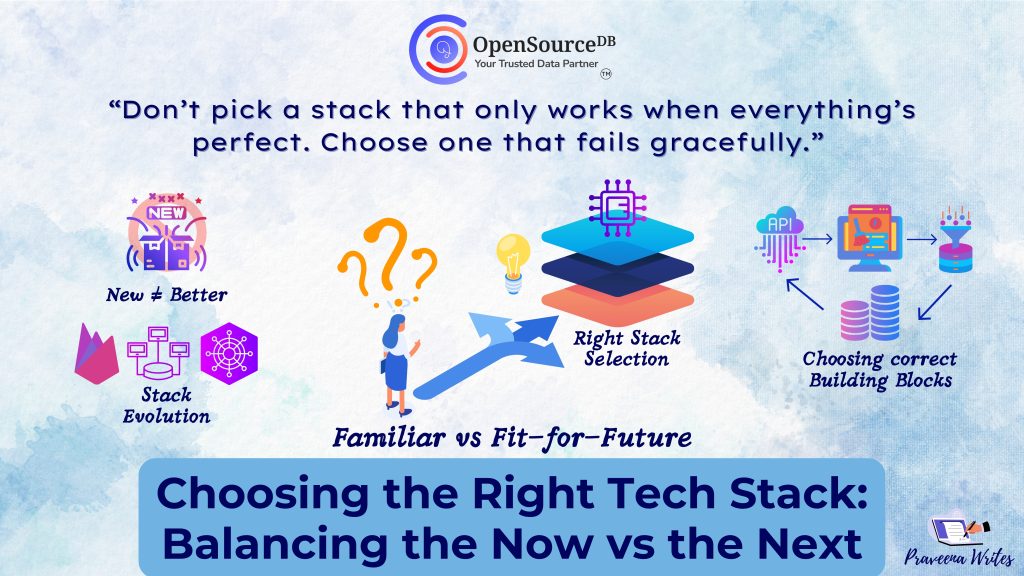
Choosing the Right Tech Stack: Balancing the Now vs the Next
When you’re building a product — especially in a startup environment — choosing the right tech stack can feel like walking a tightrope. On one side is what you know. On the other, what your product needs to survive and scale.
Welcome to the Founder’s Dilemma: Familiar vs Fit-for-Future.
The Founder’s Dilemma: Familiar vs Fit-for-Future
In the early days, you’ll likely reach for tools you’re most comfortable with. Maybe that’s Python and Django, or Node.js and Express. It’s fast, familiar, and you know how to get stuff done.
But will it scale?
As your product matures, you may realize that concurrency-heavy workloads scream for Go, performance-critical code runs better in Rust, or you need the fault-tolerance that Elixir brings to the table.
Tip: Choose a stack that aligns with both your team’s current strengths and your product’s future trajectory. Don’t sacrifice scalability for comfort — or vice versa.
📌 Criteria for Stack Selection
Before you commit to a stack, ask yourself:
1. Maturity of the Ecosystem
Is it proven in production? Are there robust libraries and tooling available?
2. Community Support
Will you find help when you’re stuck? Strong communities = faster troubleshooting.
3. Operational Overhead
How easy is it to deploy, monitor, and debug? A powerful language is useless if it’s a nightmare in production.
4. Talent Availability
Can you hire engineers who know this stack? Or will onboarding take months?
🧱 Choosing the Right Building Blocks
Once you’ve picked your core stack, it’s time to assemble the rest of your architecture. Be deliberate.
API Gateways
- Simple: NGINX or Express proxy
- Advanced: Kong, Ambassador
Queue Systems
- RabbitMQ: Great for simple job queues
- Kafka: Better for stream processing and high-throughput systems, but requires more setup
Caching
- Redis: The default choice for most startups. Blazing fast and versatile.
Databases
- PostgreSQL: A solid general-purpose choice that handles most workloads well
- NoSQL (MongoDB, DynamoDB): Useful for flexible schemas or when speed/scalability needs trump relational structure
🚨 Avoiding Shiny Object Syndrome
Tech moves fast — but that doesn’t mean you should.
Just because something’s trending on Hacker News doesn’t mean it belongs in your stack. We’ve all seen it: a team using blockchain for a to-do app, or spinning up Kubernetes clusters before writing a single test.
New ≠ Better.
Choose what’s proven, maintainable, and sustainable — not just what’s flashy.
Ask yourself:
- Is this tech battle-tested?
- Can my team maintain it?
- Will it still make sense in 2–3 years?
🔄 Stack Evolution in Phases
Your stack should evolve with your product. Don’t over-engineer on Day 1 — but don’t under-engineer forever.
Phase 1: Just Ship It
- Tools: Heroku, Firebase, monoliths
- Goal: Validate the idea fast
Phase 2: Build for Growth
- Tools: AWS/GCP, microservices, CI/CD
- Goal: Improve performance, scalability, and developer velocity
Phase 3: Platform Maturity
- Tools: Kubernetes, Terraform, observability tools (Grafana, Prometheus)
- Goal: Resilience, automation, and ops excellence
💡 Closing Thought
“Don’t pick a stack that only works when everything’s perfect. Choose one that fails gracefully.” – Hari Kiran
In the real world, servers go down, APIs timeout, and deployments break. Your tech stack shouldn’t fall apart at the first sign of trouble.
Choose tools that help you recover, debug, and move forward — not ones that require perfection to function.
TL;DR:
- Start with what gets you moving fast.
- Plan for what helps you scale smart.
- Always optimize for resilience, not trendiness.
📌 Coming up next in Architecting August – Week 3:
Infrastructure Decisions That Save You Headaches Later
